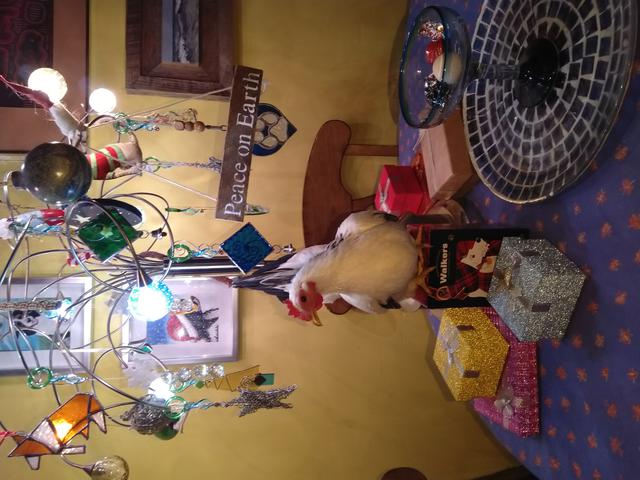Call us at (905) 473-6116
Please email us with any questions
ROVERDALE Board & Biscuit
BED WARS
By Luan Egan
Many relationships are established in bed. Sure, nooky is nice, but if you can’t settle down and get a good night’s sleep together, the prospects for a long-term relationship look dim. Restlessness, snoring, hogging the bedclothes, it all make settling in for the long haul a challenge. But when the disruptive party starts to growl, show teeth, even snap or bite, someone’s got to sleep on the floor, and it better not be you. Sound like a case for Divorce Court? I’m talking about building a healthy relationship with your dog!
I have never had a problem with Bed Buddies. I do not have this issue because I never allowed it to take root. It has, however, become an issue for some pet owners, and then we have to look at why.
May I offer some suggestions?
Cuddling on the furniture with your dog is comforting, and something that many dog owners expect to enjoy. But one has to take into consideration how the doggie mind works. Many like to resource-guard, be it food, attention, where they like to sleep. They like it, you reward it, by allowing them to get what they want. If you left a bowl of candy out, and did not set any limits on your kids sugar intake, don’t be surprised if they don’t have room for dinner, and are swinging off the chandelier. Once they have a taste for gluttony, it is harder to scale back. You need to set boundaries, and if you are not clear on them from the get-go, there is no one to blame but you if things get out of hand. But don’t give up. It may take some time, and a commitment to upgrading your skills, but you can still have the companion of your dreams.
Your dog jumping up on the couch, chair or bed may be seeking a comfy place to relax, but from the start, it is a privilege that you have to have some control over, even if you don’t mind the hair on the furniture or a head in your lap while reading or watching the telly. From day one, I recommend NEVER allowing your dog on the furniture unless you are confident they will get off when told to. If you do find yourself in a battle of wills that you did not anticipate, think of the old saying “you get more flies with honey than vinegar”. Better to lure the pet off or away with a ball or tasty treat, and reward it for leaving the confrontation. You are not spoiling, you are using your brain cells to de-escalate and control the situation in a positive way.
Teach your dog “Off”. Off the furniture, paws off you (jumping up) and paws off the counter or table. Some people use “Down” for this behaviour but this can confuse the dog as the training command “Down” is usually used to achieve a lie down. This is something that I work on when on walks, and I will teach my dog to jump up on a park bench or low retaining wall, walk along it, and off on the other end. In the house, attach a short leash (short enough not to trip on) to your dog’s collar and leave it on. That way you have something to take a hold of and patiently lead with, rather than reaching for the collar. I also use a body harness with dogs that have issues with being taken by the collar, with the lead attached to that. Most aggression is caused by fear and anxiety. Often, they anticipate being taken by the collar as a step towards punishment, and react by fearfully snapping at the hand they think will dole it out. It takes time to desensitize them to being controlled and led, and having a less stressful “handle” is a huge help.
There is no need to be harsh. But if you don’t trust them to stay off when you ask, go back to crate training, or shut the door (or employ a baby gate) with them on the other side. Do this until they are 100% reliable in getting the message. Crate training is a highly recommended tool to ensure compliance and acceptance – done properly your dog will accept the crate as a good place to relax in for short or moderate periods of time or travel. There are many trainers and training manuals available to help you teach your dog to accept the crate in a positive way.
Practice “Down” or “Lie Down”. Not only is this a very useful tool to have in your arsenal, but teaching a dog to lie down and stay down will also teach them self control. Teaching your pet “Off” the bed and to “Lie Down”, and “Stay” on a mat beside it will go a long way to establishing a healthy relationship and mutual respect between dog and human. Plus, once you have mastered “Lie Down” around the house, you can try achieving compliance while increasing the distance between you and your dog, out in public and then with distractions. Nothing impresses more than having a dog drop on command at a distance, and it can help eliminate unsafe situations. I command my dogs to lie down on the forest trails if a cyclist approaches. I can’t boast 100% compliance, but I usually get two lying down and one standing still pretty quickly. It keeps them off the path and focused on me until the danger of a collision is past, and I often get a “Wow” along with thanks from the cyclist.
My dogs sleep on the bed. They all know it is a special place. They sometimes squabble amongst themselves over who got there first. I growl “Off” and the bed clears like magic. Likewise if I wake up in the middle of the night because my backside is hanging off the edge or my feet have no place to go. A simple “Off” clears the bed with little complaint and I can settle comfortably, then I say “okay, up” and my bed buddies reassemble and settle down.
You make the rules, the dog follows them, and feels rewarded for doing so. You are happy, the dog is happy.
Dogs crave structure and routine. If you don’t provide it, they might decide that they can make it up their way. Don’t be daunted. It’s not that difficult to be firm but fair while being affectionate. You can do it.
Now enjoy your bed!
Border Collie Philosophy
by Luan Egan
Washing down the kennels this morning
and I got to thinking about how
sometimes human behaviour is not so
very different from dogs.
Perfectly nice dogs that find themselves behind an artificial barrier will often bark, snark and snarl at each other. Even if a gate is opened, they will often prefer to find opposite sides of a fence and be rude for no obvious reason. If they don’t really know each other and are allowed to continue, dislike intensifies. Dogs should be encouraged to meet in a neutral setting.
Perfectly nice people, communicating on social media and by e-mail, seem to be prone to fence fighting and barrier frustration as well.
Please, have a coffee date, sniff butts , go piss on a tree and get on with things. Thank you.
BUYER BEWARE
or The Perils of Shopping for Your Lap Dog on Your Laptop
By Luan Egan
In the past few years, in an effort to curb puppy mills, Cities like Toronto have enacted laws prohibiting the sale of puppies and kittens in pet stores, with the exception of adoptions through local Humane Societies, Rescues, and Animal Shelters. While this may reduce the number of impulse purchases by pet owners, it does not address the other routes that mills use to sell to the unsuspecting public.
Internet sales are rapidly becoming the tool of choice for both sellers and buyers, and you can be assured that the buyers get no closer to the real source of their purchase through a slick website than they did at the pet stores. Mills and brokers have simply changed their game, and in many cases use deception and falsehoods to create the impression that the buyer is purchasing a quality puppy born and raised in a loving home, one where the true parents are nowhere to be found.
What is of more concern to the Mills are tightening and enforcement of Kennel Licensing Regulations. For far too long, rural puppy mills have been treated as similar to agricultural farm producers, and there has been strong opposition to changes that would reflect the fact that the majority of dogs being produced in the mills are marketed as and intended to be family pets, and need to be bred and raised to be safe and healthy.
Proper nutrition, medical care, environment, critical socialization with mother and littermates until 8-9 weeks of age, a clean and comfortable temperature controlled living environment, all of this is of far more importance than current regulations address, and those who are pushing for improvements get labeled and scorned as "Animal Rights Activists" in attempts to discredit them. This was evidenced in 2013 in Stratford, Ontario when Amish Bishop Menno Streicher and his wife Viola ended up before the Courts. Their farm’s commercial dog breeding operation was found to fail inspection or meet minimum standards. Dogs were kept in unheated, poorly ventilated conditions, regardless of breed. Injuries were not properly treated. When they were unable to remedy the issues, their kennel license was revoked and they were ordered to remove the dogs. Charges were laid by both the Municipal Bylaw Enforcement and the OSPCA. In a plea bargain, Viola Streicher pled guilty to the charges, in exchange for withdrawal of charges against her husband the Bishop.
Quaint as it may be, the Amish and Mennonite lifestyle simply is not able to support large scale farming of dogs in a humane and responsible manner, that meets the complex emotional and physical needs of animals destined to be furry family members.
No electricity, no heat or fans, limited natural light, minimal veterinary care (usually only addressing legal requirement for the pups to be moved and sold, with little or nothing done for the breeding adults). Sick or injured animals are killed rather than incurring the costs of proper Veterinary care.
These practices continue, and these proponents of a simpler life employ “outsiders” to take care of the advertising and sales of their merchandise, using the modern and up to date methods that they themselves shun.
Farming of dogs is not just a practice of Amish and Mennonite communities. There are plenty of “Greeders” taking advantage of the demand for puppies. There is concern about the growing number of commercial breeding operations in and around the GTA, and poor regulation and enforcement of this practice.
Not to mention puppies that are imported. In June 2020 500 French Bulldog puppies were imported into Canada from The Ukraine on a single flight arriving at Toronto’s Pearson Airport. 38 of those pups were dead on arrival. In September 2020 another large shipment of sick and stressed pups landed at Chicago’s O’Hare Airport, routed through Jordan from Russia before arriving in the U.S.
Brokers are also “Greeders”, and there are many people who make good money acting as Brokers. Brokers will purchase multiple litters from their Puppy Mill contacts, and then place them in urban homes while advertising them on the internet. No one involved is going to disclose to the puppy-buying public where these dogs originally came from.
As a licensed (boarding) kennel owner in the region I can tell you that the Township of Georgina, at the north end of York Region, has made substantial changes to their Kennel Licensing Regulations, including a limit to the number of dogs a breeding kennel is allowed to have on each licensed premises to a maximum of 20. There are some in our community who are not at all happy about that. People with money, people with influence, people who are making big bucks breeding dogs. People who have a vested interest in keeping things as they were.
There is no effective self-policing of the industry, much of which remains deeply hidden from public view. The Canadian Kennel Club cannot be relied on to inspect and investigate all their members. Even if a breeder you contact is a registered member, the CKC simply do not have the staff to effectively inspect and enforce their code of conduct.
Effective regulations must be in place through government, starting at the Municipal level for business inspections and licensing, moving to the Provincial and Federal levels for Animal Welfare and Health and Safety. The levels must work together to be effective.
There are some who will argue that dogs do not feel pain, do not have complex emotions, can handle living in extreme conditions. The more dogs are studied and their behaviour researched, the more people are coming to realize that these claims simply are not true, and dogs forced to live such lives are pretty miserable. Living in misery is very stressful. Living in such stressful conditions for prolonged periods affects health, compromises immune systems, and can literally make genetic changes that can affect offspring.
But calling for improvements in animal welfare regulations, demanding changes in licensing requirements to improve living conditions and provide better inspection and enforcement, is to risk being labeled an Activist, or a bunch of crazy loons, who call their pets Furkids, and treat them like children or relationship substitutes. Not people who should be taken seriously. Quite frankly, this tactic is getting old.
As Arlo Guthrie said back in the days of peace, love and the anti-war Sixties, if you speak out alone (or sing a bar of Alice’s Restaurant) they say you are crazy. But when people start speaking out in groups with the same message, and those groups become movements, they get noticed. When those movements demand change, they will attract attention. When they attract attention, they will be ridiculed and discredited. When they persist, they start to change perceptions. Years later, when what they were calling for is considered acceptable, people will wonder why it didn’t happen sooner.
This is a good time to start letting your elected officials know that this is an issue that their constituents want addressed. If you care about where you get your next pet, you need to care about having regulations in place to govern the breeding industry properly, and enforce transparency. As a consumer, you can’t get enforced what they don’t regulate. So don’t be afraid to be called an Activist!
December 2020
Rescue Dog Agencies, How To Find The Good Ones!
Recently I was contacted by Judy and was asked for input on an article she was writing about choosing a good Dog Rescue Agency. Thanks to Covid and the resulting halt in most people's travel plans, I had plenty of time to answer her questions. Now the Blog article has been posted, and I hope you find it useful. To read, click
Covid may have slowed boarding business, but the Rescues I work with have kept me busy, and I've usually had one or two foster dogs here for assessment or emergency foster at any one time. Right now I have Doris here for Speaking of Dogs. She is a very elderly little Border Collie mix that sadly has rapidly advancing mammary tumors and a touch of dementia. Her advanced age means that surgery is not an option. But so far she still has quality of life, can get her legs under her and walks around the yard, and loves her food. Her nose works very well! I brought home some rib bones yesterday from T&T and she was in heaven. She just visited the Vet for x-rays and a series of needle biopsies on her tumors, and we are awaiting the results. But either way, she has a home here for as long as she needs one.
I am also taking advantage of the business slowdown to get some other things done at Roverdale. New outdoor runs are being installed...finally! Once the walls are all in, I can measure properly and order the gates. When the West side is fully finished, then the East side will be done. That way I still have space available when needed. Also, finally getting the cleared area in the back safely fenced and levelled so that it can be seeded in Spring. Thinking about putting in an Agility Field that can be rented for practice, or a safe area where people can bring their dogs for exercise if the Dog Park is not suitable.
As 2020 draws to a close, I am thankful that I have managed to stay afloat, and stay healthy... my back is feeling so much better! I am thankful also to you, dear Clients, and I hope to see you all again soon, when travel is safe once again. Wishing you all a Merry Christmas, Happy Hanukkah, A Peaceful Yuletide/Winter Solstice, and a safe and Happy New Year!









